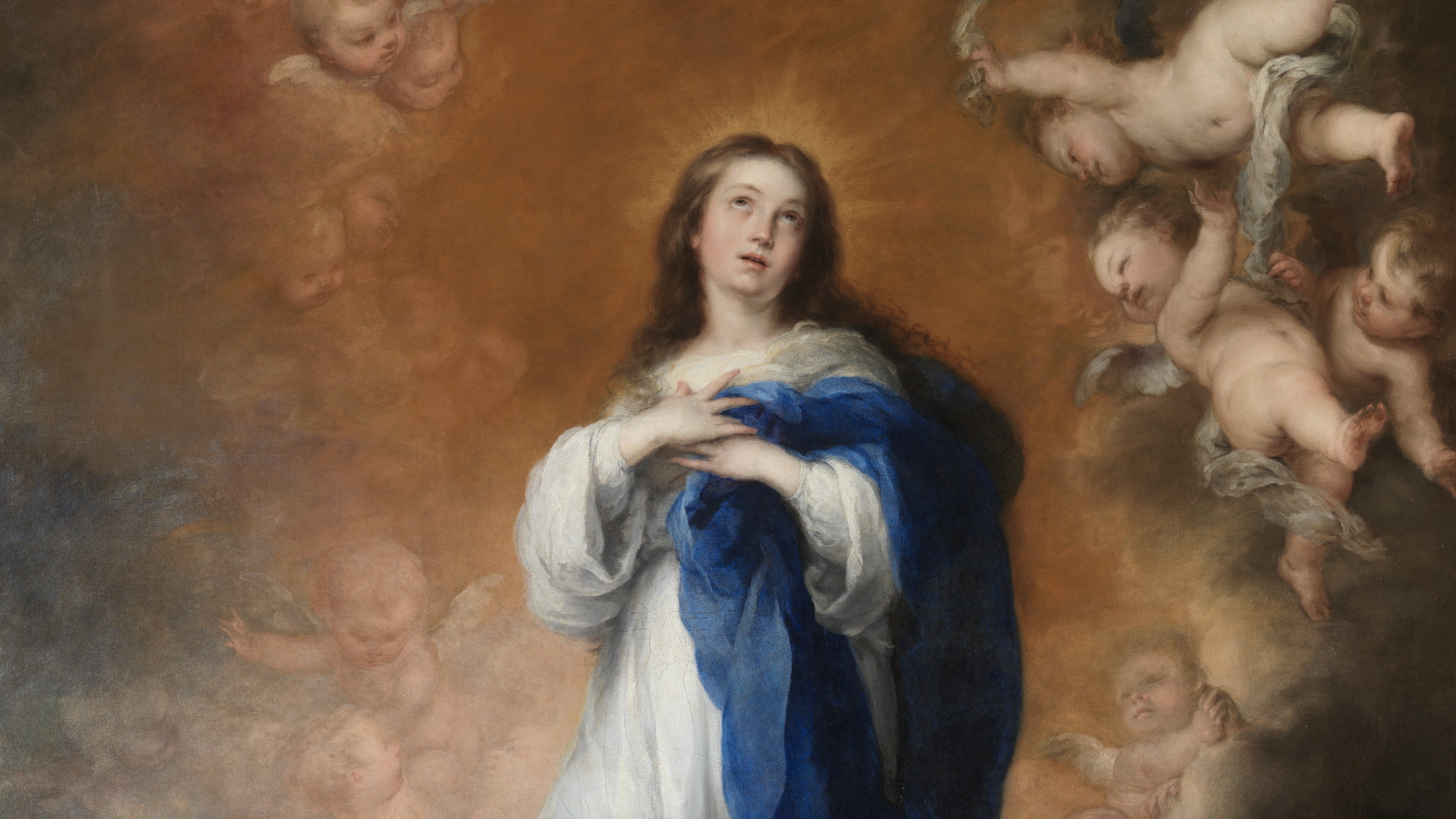With the unraveling of Christendom that began in the late Middle Ages also came the theological fracturing of the orders of nature and grace, the rending of the temporal and the spiritual orders, the distancing of the Church on earth from the Church in heaven. Once one has begun to conceive of nature independently from grace, every optimistic exaltation of nature will invariably end in disappointment.
While the Renaissance humanists were praising nature and exalting the natural virtues of Greeks and Romans, another view of human nature had been brewing, one that would find its culmination in Luther’s doctrine of total depravity. If nature is totally depraved and there is no hope for its redemption, then why bother with it? Why not leave it behind and focus on grace alone? While in Catholic circles the relationship between nature and grace remained in tension, in Protestantism, it reached the point of total rupture. Nature and grace became effectively separated. The natural light of reason was no longer deemed capable of being perfected by faith, so one had to choose one or the other. Luther chose faith alone. The constant delays and political hindrances obstructing the Council of Trent allowed confusion to go unchecked for far too long. The Protestant doctrine of the total depravity of human nature would continue spreading with a new development, one that would have scandalized Luther.
If nature and grace can be separated, why should it be nature that is set aside? Why not grace? If grace does not perfect nature, if it effectively does nothing, it becomes irrelevant. This was Thomas Hobbes’ view. His was a Protestantism that had lost its faith. Likewise, if reason and faith are no longer intrinsically related, then one can just as easily opt for reason instead of faith. This was the birth of the entire Enlightenment project.
The Council of Trent set out to correct these mistakes. To the doctrine of total depravity, it opposed the orthodox view that nature is fallen, without the possibility of redeeming itself, but grace not only justifies but sanctifies it. Grace is effective, here and now, redeeming, elevating, and perfecting nature. In offering human nature the possibility of genuine sanctification, the council also brought faith and reason back together. While the ecclesial authorities in the council offered to the Reformation and its Liberal-Enlightened offspring a response in the form of doctrinal statements, decrees, and canons—in other words, in a correct theology—the people of God offered one that was far more concrete and incarnate, a woman of flesh and blood, a woman who perfectly exemplifies the degree of perfection that grace can effect on human nature: the Blessed Virgin Mary. Nothing proves Protestantism and Liberalism wrong like the Immaculate Conception.
The beauty of his figures does not conflict with their naturalness but rather elevates and perfects it.
The Council of Trent did not proclaim any doctrine on this specific matter, stating only that what was decreed concerning original sin did not apply to the Blessed Virgin Mary.1 Despite the council’s refusal to go any further on the matter, devotion to the Immaculate Conception spread among the people and was especially fervent in Spain, where commissions for paintings, prints, and sculptures of the Inmaculada multiplied. In 1617, Pope Paul V issued a decree prohibiting any preaching against the Immaculate Conception. The decree was received with great joy in Spain, and in Seville in particular, where the celebrations lasted for days.2 That same year, in that same city, Bartolomé Esteban Murillo was born. Murillo was to become the last of the masters of the Spanish Golden Age of painting. His oeuvre was the culmination of over a century of artistic development that saw some of the most important and influential painters in Western art: El Greco, Jusepe de Ribera, Francisco de Zurbarán, Diego Velázquez. Though Murillo was not the greatest of these, none of them rivals him in expressing the vision of Trent on canvas. He was to become the most widely recognized painter of the Inmaculada.
The intellectual climate and the artistic trends of each age are inseparable. Art will always express the intellectual mood of its day. The growing tension between nature and grace that accompanied the dissolution of medieval civilization can also be traced artistically. Fra Angelico’s supernatural idealism, as seen, for instance, in his Annunciation (1441-1450), would give way to the classical idealism of the high Renaissance. Not only the glorified Christ and his saints in heaven but even the demons and the damned in Michelangelo’s The Last Judgment (1536–1541) have the perfect physique of a Greek statue. The early Baroque saw a turn toward naturalistic realism. Caravaggio’s naturalistic tenebrism—with its stark contrast between light and shadow—conveys a far more somber mood than the colorful optimism of the Renaissance. The Spanish school would perfect this tenebrism, pushing the tension between light and darkness to its limit, reflecting the spiritual and intellectual struggle to properly understand the relationship between nature and grace. Their naturalism also went further, not shying away from gruesome scenes of martyrdom, from the ugly and deformed, and even the grotesque.
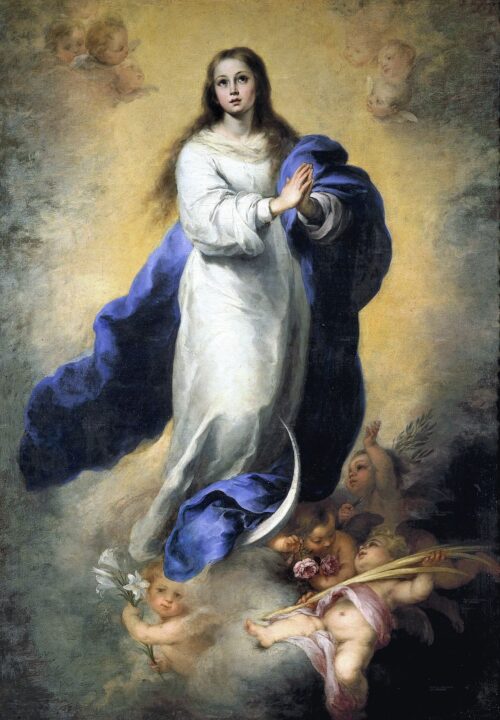
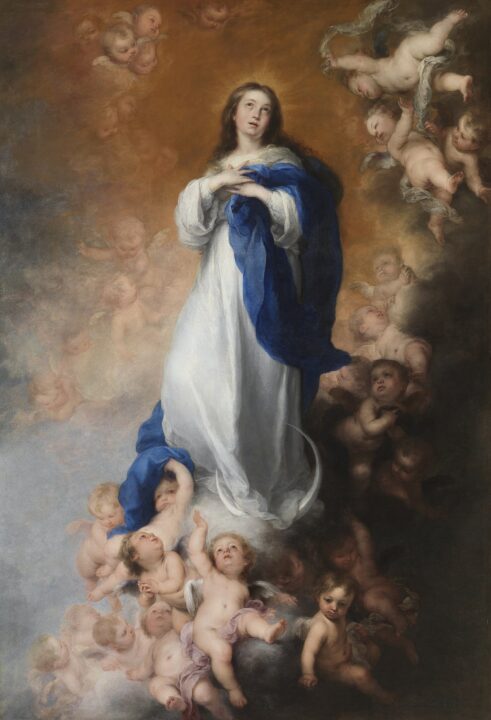
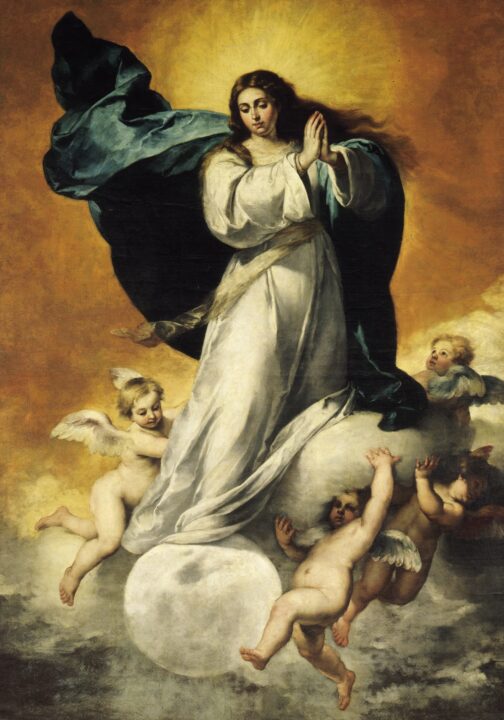
Murillo would begin his career at the tail end of this period. Enough time had passed since the closing of the council for its teachings to take hold. Murillo’s early works still bear a strong tenebrist character, but his naturalism moves away from the harsh, the ugly, or the grotesque without falling into an idealized artificiality. The beauty of his figures does not conflict with their naturalness but rather elevates and perfects it. It is precisely their exalted beauty that makes them appear more natural. Nowhere is this more evident than in his depictions of the Immaculate Conception.
Many of the Spanish masters struggled with portraying the Immaculate Conception, falling either into the overly saccharine and pious, and thus artificial, or in the opposite extreme, into a hyper-realism disconnected from the supernatural. Some of Zurbarán’s early efforts fall into the former category, while the great Velázquez was guilty of the latter. Murillo, on the other hand, manages to render the Blessed Virgin with a supernatural naturalism, showing visually the perfecting and elevating effect of grace on her nature. The iconography for the pictorial representation of the Immaculate Conception was taken from St. John’s vision in the book of Revelation: “A great sign appeared in the sky, a woman clothed with the sun, with the moon under her feet, and on her head a crown of twelve stars” (Rev. 12:1), to which were commonly added symbols of the Litany and of her purity. Murillo radically simplified this iconography, keeping almost exclusively the image of the woman clothed in the sun, dispelling the dark background favored by the tenebrist tradition with one of a luminous yellow. Grace does not abandon nature to darkness: “The dawn from on high shall break upon us, to shine on those who dwell in darkness and the shadow of death, and to guide our feet into the way of peace” (Luke 1:78-79). Even the colors he favors express the proper relationship between nature and grace. The contrast between the warm background and the cooler mantle and robe of the Blessed Virgin emphasizes that, though the Virgin is completely enveloped in the light of the sun—Christ, “the true light, which enlightens everyone” (John 1:9)—she remains herself. The Blessed Virgin is more fully herself because of the light of grace: “I have come that you might have life and have it to the fullest” (John 10:10). At the same time, God is glorified in glorifying his creature, as St. Irenaeus rightly saw. This harmonious understanding of the interplay of nature and grace is the exact opposite of Luther’s.
Standing in front of one of Murillo’s Inmaculadas, the desire of our nature for its own elevation and perfection by grace is stirred anew.
Though Murillo is the painter of the Immaculate Conception par excellence, that was not the only theme by which he refuted the distorted view of human nature brought about by Luther and his heirs. If human nature is totally corrupt, and man is social by nature, then his natural relationships will also be entirely corrupt. What matters, then, is the relationship between each individual and God, with all the communities the individual belongs to being, at best, a necessary evil. Again, Hobbes would take this to its logical conclusion, stripping any reference to a relationship with God and grounding all human relationships on the inherently self-interested interactions between individuals.
The Catholic tradition had always understood that the family was the most natural community, founded on the marriage of one man and one woman. It had always understood marriage as a natural institution elevated by grace to a sacrament. That most natural of institutions was made, by grace, into the locus of sanctification for the majority of men and women. Luther denied all of this, redefining marriage long before the Supreme Court did—and unknowingly laying the ground for the latter’s mistaken decisions centuries later. The Council of Trent insisted on the sacramentality of marriage, reminding the faithful of its power to sanctify the married couple. If the Immaculate Conception is the best example of grace’s sanctifying power on the person, the Immaculate Conception’s family—called the “Holy Family,” not as sentimental piety but as a statement of fact— reveals that this sanctifying power of grace happens within a community of persons.
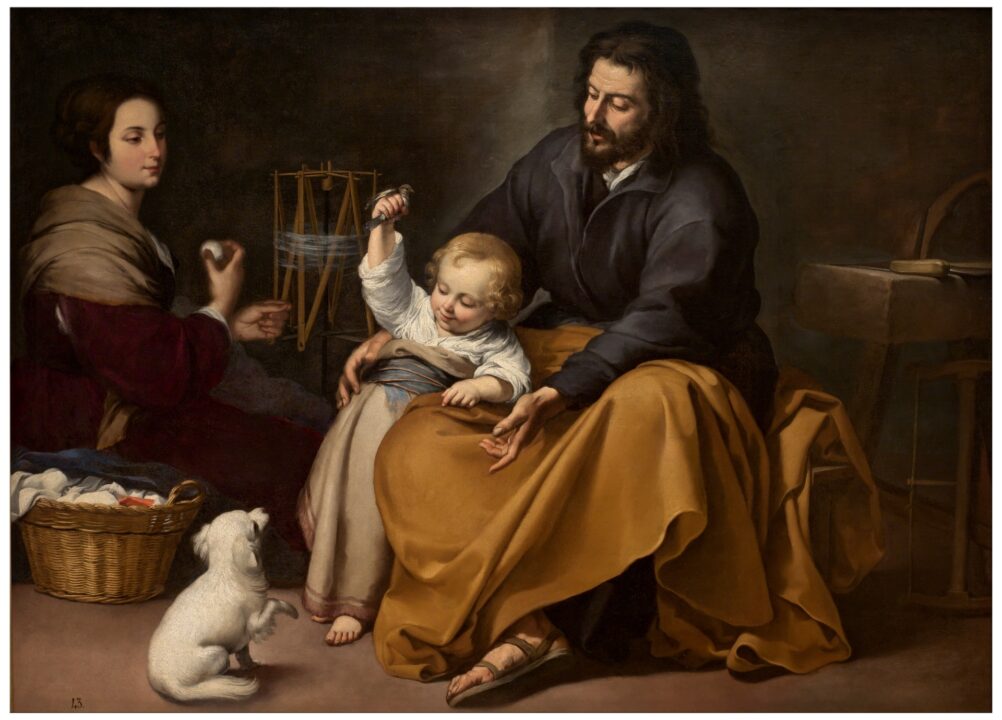
This was not ignored by Murillo, who gifted us with some of the most moving portraits of the Holy Family. In The Holy Family with a Little Bird, we are drawn into a scene that could have been taken from the daily life of any family: a mother watching her husband joyfully playing with their son. The Counter-Reformation brought about an important iconographic change in the representation of St. Joseph, one that Murillo was among the first to embrace. St. Joseph is shown in the vigor of his youth, virile and not senile, as he had traditionally been portrayed. He no longer lurks in the background but is front and center, alongside his wife and foster son. St. Joseph was not immaculately conceived but was sanctified by grace. All Christians are called to deification by grace, which involves a genuine transformation. By grace men are deified, but they are deified in and through the Church, and not only the universal Church but also the domestic church. This last point is made most clear in The Heavenly and Earthly Trinities, which is one of Murillo’s two treatments of the theme of the Holy Family as an image of the Blessed Trinity. Anticipating St. John Paul II’s theology of the body, Murillo shows that the communion of persons that is marriage was created to be an image of the communion of persons that is the Trinity. The Christ child links both trinities, for it is in him that the divine nature and human nature are brought together. He is the source of the divinization of human nature, as St. Athanasius famously said: “The Son of God became man so that we might become God.” The sanctifying orientation of marriage is not limited to the family, because the latter is not a self-enclosed reality. On the contrary, the family is inherently open towards the broader community, towards the polis. As St. John Paul II remarked in an oft-quoted homily: “As the family goes, so goes the nation, and so goes the whole world in which we live.” If the family is the ordinary place of sanctification, so are the communities that have it as its foundation. By sanctifying the family, the political community is sanctified: holy families are what constitute the city of God. Nothing proves Liberal politics wrong like the Holy Family.
Despite the Council of Trent’s and the Counter-Reformation’s best efforts, the breaking up of grace and nature set in motion by Luther would continue its downward path. The Enlightenment’s experiment in elevating human nature without grace, enshrined in the French Revolution’s motto of Liberté, Egalité, Fraternité, led to the guillotine. By the nineteenth century, Darwin’s theory degraded human nature by denying it any substantial difference from the beasts. Its supernatural aspirations were explained away as wishful thinking, an evolutionary mechanism that was no longer needed. That path led to the bloodshed of two World Wars, concentration camps, and the gulags. Parallel to this broad road leading to destruction, the Church continued walking along the narrow way. Less than two centuries after Murillo’s death, in 1854, Pope Pius IX officially declared the dogma of the Immaculate Conception. Standing in front of one of Murillo’s Inmaculadas, the desire of our nature for its own elevation and perfection by grace is stirred anew, seeing its vocation and dignity so wonderfully portrayed. Murillo, in unison with the whole Catholic tradition, showed that this yearning is not in vain.
1 Council of Trent, Decree concerning Original Sin, §5.
2 Schroth Sarah and Baer Ronni, El Greco to Velázquez. Art during the Reign of Phillip III (Boston: MFA Publications, 2008), 260.
